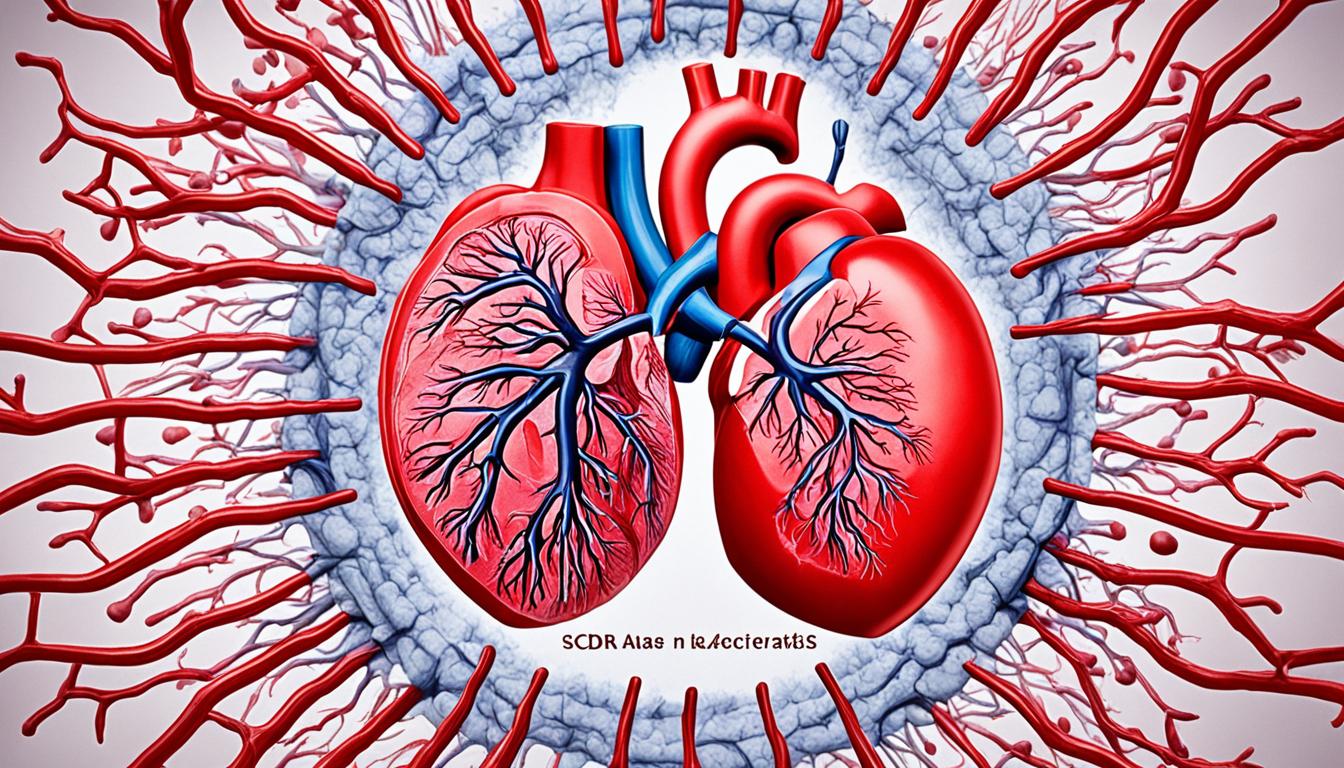Spontaneous coronary artery dissection (SCAD) is a tear in a big heart artery’s wall. This tear can block blood and lead to heart problems. It often happens in young, healthy women.
The exact reason for SCAD is not clear. But, we think it might be linked to issues like unusual artery wall growth, being female, and intense stress.
The signs of SCAD range from slight chest pain to heart attack symptoms. Doctors can tell if someone has SCAD by doing tests like a cardiac catheterization. Treating SCAD might involve drugs, putting in a stent, heart bypass, or using stem cells.
Key Takeaways:
- SCAD is a tear in the coronary artery that restricts blood flow and leads to myocardial ischemia.
- It is an emerging cause of acute coronary syndrome in young women without traditional risk factors.
- The exact cause of SCAD is not fully understood but is believed to be influenced by factors such as fibromuscular dysplasia, hormonal changes, and extreme stress.
- Diagnosis is made through cardiac catheterization and coronary angiogram.
- Treatment options for SCAD include medication, stent placement, bypass surgery, and stem cell therapy.
This article starts by looking at SCAD’s signs, what might cause it, and how doctors find it. Knowing these can lead to better treatments. We’ll also talk about stem cells and how they could change SCAD treatment. Let’s get into more information.
Understanding Spontaneous Coronary Artery Dissection (SCAD)
Spontaneous Coronary Artery Dissection (SCAD) involves a tear in a major heart artery. This can block blood flow and cause chest pain and harm to the heart muscle. It’s more common in young women, especially those who are pregnant or have recently given birth. Surprisingly, they often don’t have standard heart risk factors.
The specific reasons behind SCAD are still unclear. However, experts link it to things like unusual artery structure, hormone shifts, sudden body fluid changes, severe stress, and hidden artery diseases. These issues together may create a situation where a heart artery tears, affecting blood flow and leading to heart muscle damage.
SCAD shows up with several symptoms. These include a fast heartbeat, chest discomfort, feeling like you might pass out, upset stomach, and not being able to catch your breath. Keep in mind, everyone’s symptoms can be slightly different. If you feel any of this, see a doctor as soon as possible.
Many tests help doctors figure out if SCAD could be the cause. These include looking inside the heart with a camera, an ultrasound test, and detailed x-rays (CT scans). They help find if there’s a tear in the heart artery and how it’s impacting blood flow.
Signs and Symptoms of SCAD
SCAD’s signs and symptoms can overlap with those of other heart issues. Symptoms often include:
- Rapid heartbeat
- Chest pain
- Dizziness
- Nausea
- Shortness of breath
If you notice any of these signs, it’s crucial to see a doctor quickly. Early diagnosis and proper care are essential for managing SCAD effectively.
Understanding SCAD and its symptoms is key for catching it early and getting the right help. With the right care and support, people with SCAD can work towards better heart health and well-being.
Managing Spontaneous Coronary Artery Dissection (SCAD)
The way we treat spontaneous coronary artery dissection (SCAD) depends on how bad it is. For those who are stable, doctors might just watch and wait. This is because many times, the dissections heal without much help.
Medications play a big role in SCAD treatment. Patients might take aspirin, blood thinners, or drugs to lower blood pressure and cholesterol. These medicines work by keeping blood from clotting, lowering blood pressure, and managing cholesterol.
If the situation is serious, more direct action might be needed. This could mean putting a stent in the artery or doing bypass surgery. Stents are tiny tubes that help keep arteries open. Bypass surgery finds another way for blood to flow around the damaged area.
Rehabilitation after a SCAD event is key. These programs offer exercise, advice on healthy living, and emotional help. They’re designed to get patients back to feeling and being their best.
To lower the risk of SCAD, it’s good to focus on heart health. This means eating well, moving your body often, keeping your cool, and steering clear of smoking and too much drinking.
Comparison of SCAD Treatment Options
| Treatment Option | Description |
|---|---|
| Medications | Prescription of aspirin, blood thinners, blood pressure drugs, and cholesterol-lowering medications to manage the condition. |
| Stent Placement | Insertion of a small mesh-like tube into the artery to keep it open and restore blood flow. |
| Bypass Surgery | Redirecting blood flow around the damaged artery by creating a new pathway using blood vessels from other parts of the body. |
| Cardiac Rehabilitation | Comprehensive support program that includes supervised exercise sessions, lifestyle counseling, and emotional support to aid in recovery. |
Choosing the right care for SCAD is best left to healthcare pros. They can make a plan that fits just you. Because everyone’s situation is different, a custom approach is key to doing well.
Conclusion
Spontaneous coronary artery dissection (SCAD) is a rare but serious condition. It can cause heart problems in young women, even if they don’t have the usual risk factors. The main cause of SCAD is not completely known, but it seems to involve several things like changes in the blood vessels, hormones, and stress.
Doctors diagnose SCAD using tests like cardiac catheterization and coronary angiogram. The treatment depends on how bad the condition is. It can include drugs, putting in stents, surgery, and a program to help the heart recover.
Lately, scientists have been looking into stem cell therapy for SCAD. The Victor Chang Cardiac Research Institute in Australia is at the forefront of this research. Their work is looking into the genes and other factors that might cause SCAD. This research offers hope for better ways to treat and help people with SCAD.

